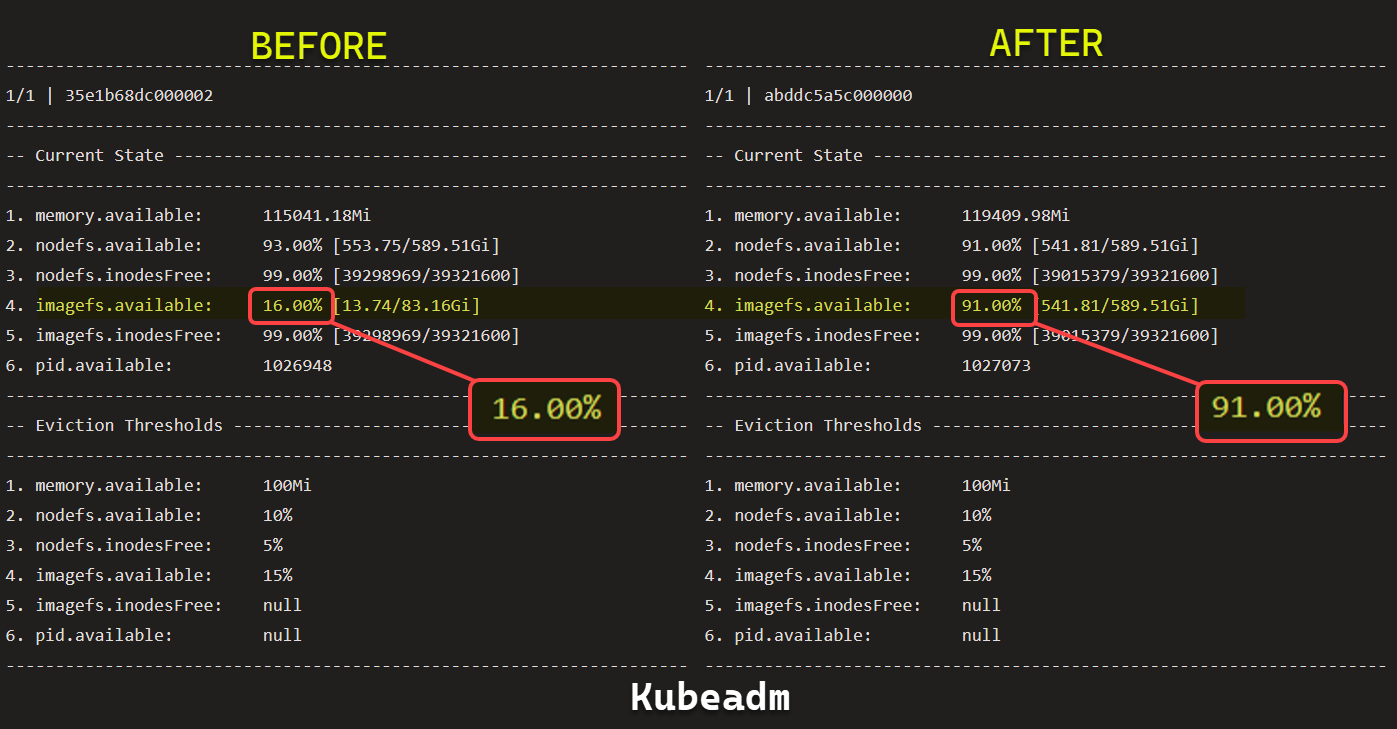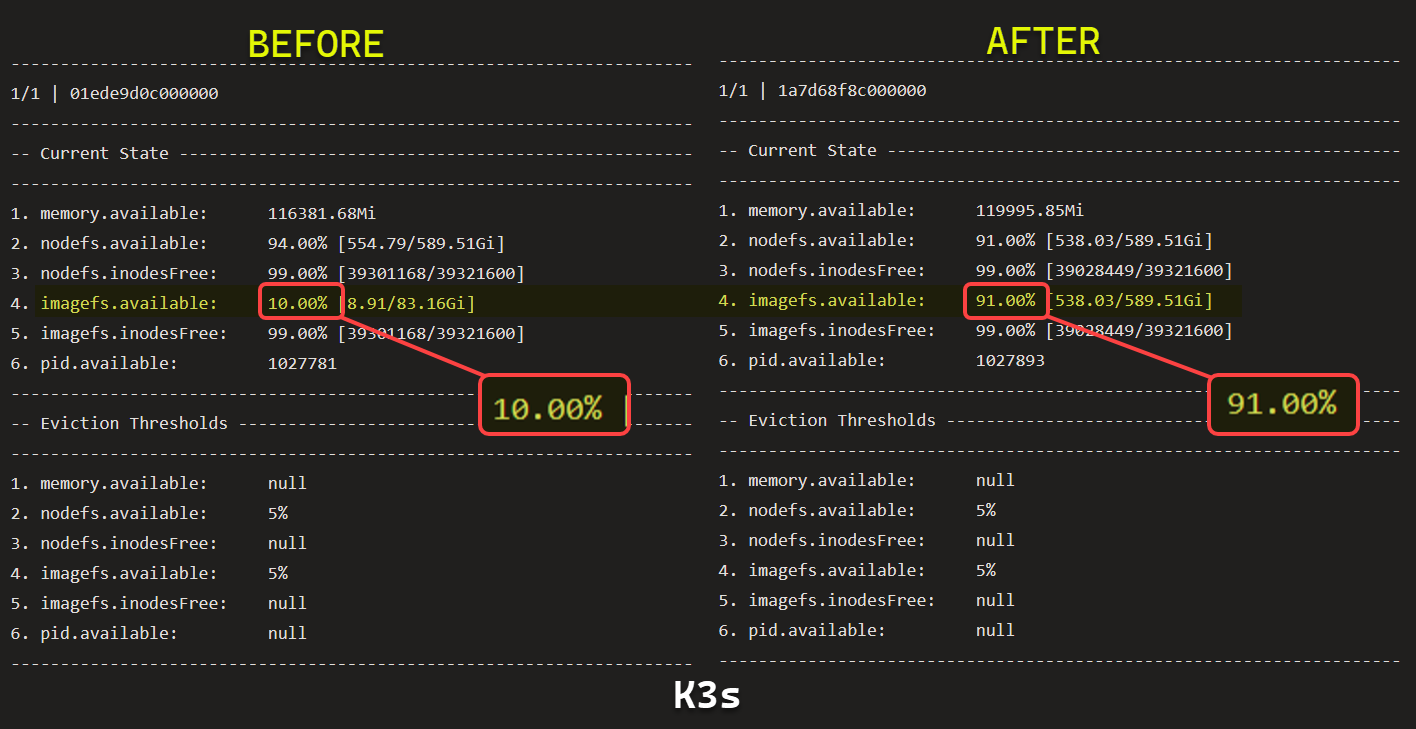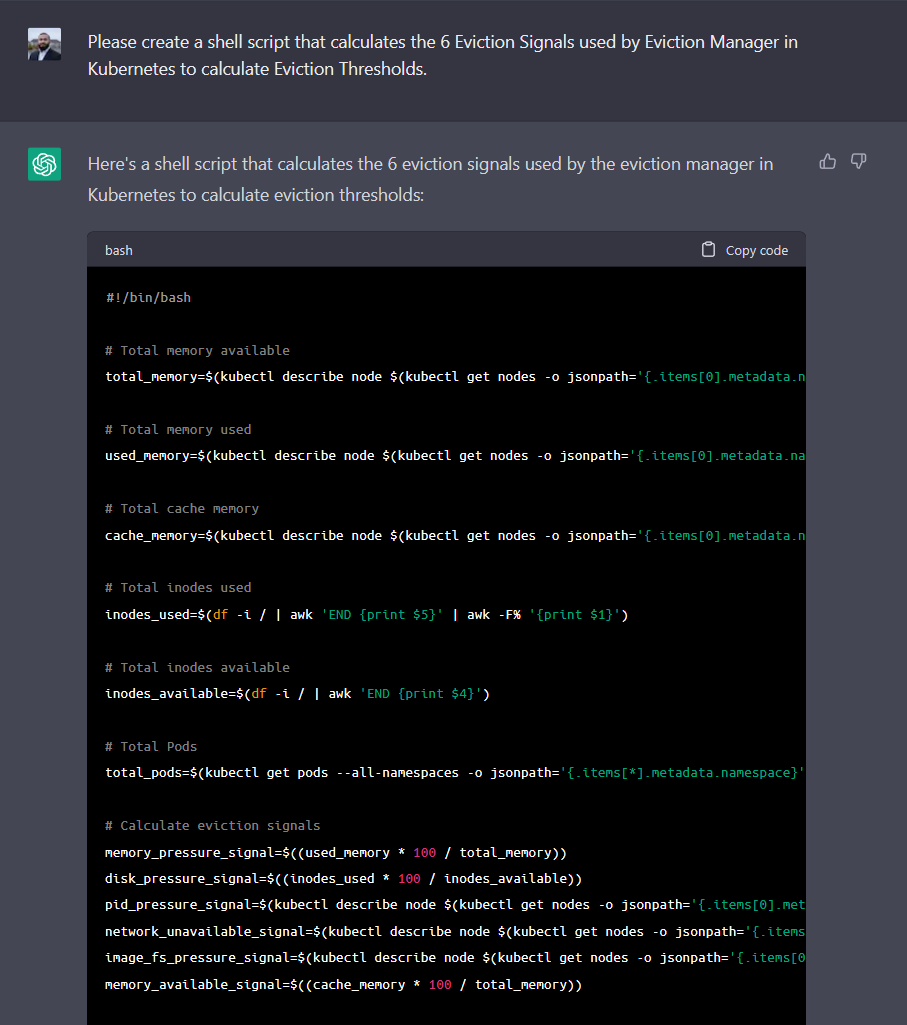Conquering Eviction Manager in Kubernetes
Eviction Manager is probably the most annoying, the most critical component of Kubernetes.
It's a Kubernetes Operator responsible for Node-pressure Eviction - or in simpler words:

Basically, it keeps Kubernetes up and running by protecting the nodes.
The annoying part is when as an end user of Kubernetes, you're just trying to run some workloads, and are suddenly faced with this:
kubelet[25910]: I1226 07:49:26.395164 25910 eviction_manager.go:351] "Eviction manager: must evict pod(s) to reclaim" resourceName="ephemeral-storage"
kubelet[25910]: I1226 07:57:57.626197 25910 eviction_manager.go:369] "Eviction manager: pods ranked for eviction" pods=["your-precious-namespace/your-precious-pod-1" ...]
kubelet[25910]: I1226 07:49:46.845358 25910 eviction_manager.go:577] "Eviction manager: pod is evicted successfully" pod="your-precious-namespace/your-precious-pod-1"
kubelet[25910]: I1226 07:49:46.845358 25910 eviction_manager.go:577] "Eviction manager: pod is evicted successfully" pod="your-precious-namespace/your-precious-pod-2"
...When this happens to your day-to-day workloads one too many times, the biggest goal is to usually figure out the why/when/how it triggers.
Kubernetes documentation provides a mysterious definition of 6 eviction signals Kubelet tracks:
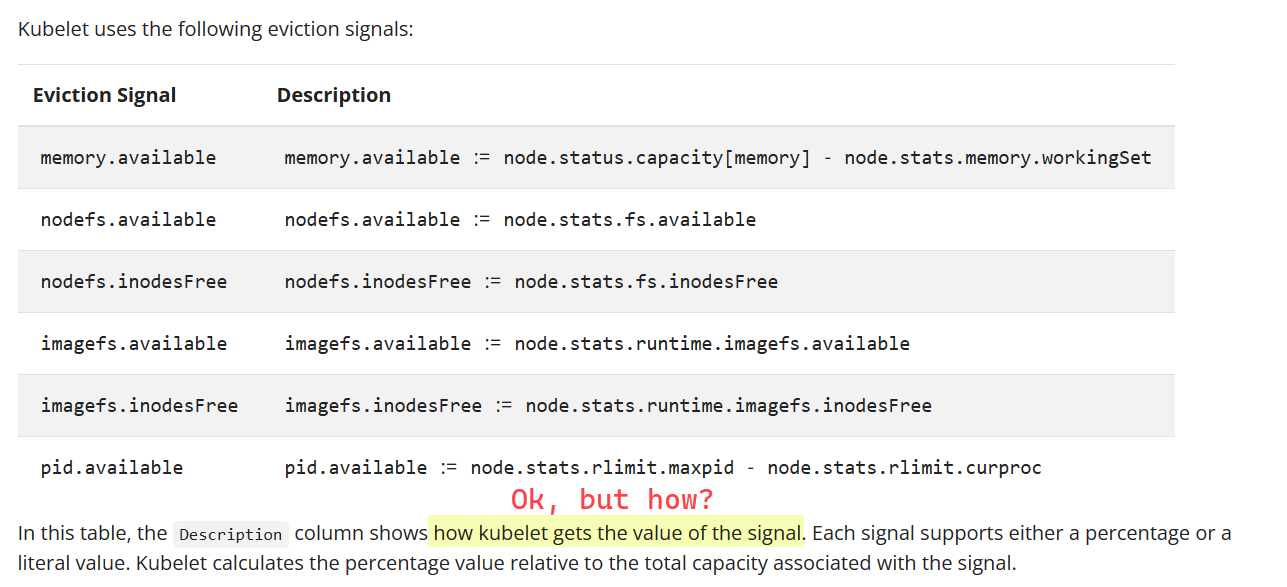
There are many Stack Overflow threads [1, 2] from folks that are equally in the dark. So from there, if you start to take matters into your own hands to read through Eviction Manager's control loop from source code on Github, it's even more confusing to figure out what signals the control loop uses to actually fire.
Kubernetes, being a distributed system, doesn't give you a straight line view of all the logs from all Control Plane pods that leads to a trigger that leads to evicted workloads.
My team self-manages a small fleet of Kubernetes Clusters that became a victim of Eviction Manager across the board. After banging my head against the wall for a couple days of seemingly random evictions, I managed to figure out the actual calculations required to figure out the 6 signals above, so we can know at any given point in time, how close Eviction Manager is to waking up:
# HH:MM:SS
#
timestamp() {
date +"%T"
}
# Prints the eviction signals (current state vs threshold) used by kubelet for pod evictions
# for all nodes. Kubelet gathers these metrics from cadvisor running on the node.
#
# - https://kubernetes.io/docs/concepts/scheduling-eviction/node-pressure-eviction/#eviction-signals
# - https://github.com/google/cadvisor
#
print_node_pressure_signals() {
if [ $# -eq 1 ]; then
export PHASE=$1
else
export PHASE="default"
fi
echo "=================================================================================="
echo "$(timestamp) | INFO | Eviction signals for all nodes"
echo "=================================================================================="
echo
echo "- - - - - - - - - - - - - - - - - - - - - - - - - - - - - - - - - - - - - - - - - "
echo " Phase: ${PHASE}"
echo "- - - - - - - - - - - - - - - - - - - - - - - - - - - - - - - - - - - - - - - - - "
NODES=($(kubectl get nodes -o jsonpath='{.items[*].metadata.name}'))
NODE_COUNT=${#NODES[@]}
for ((i=1; i<=${NODE_COUNT}; i++)); do
NODE=${NODES[$i-1]}
# =======
# Refresh
# =======
CURRENT_PAYLOAD=$(kubectl get --raw "/api/v1/nodes/${NODE}/proxy/stats/summary");
THRESHOLD_PAYLOAD=$(kubectl get --raw "/api/v1/nodes/${NODE}/proxy/configz");
# ====================
# Current Calculations
# ====================
# -- 1. Memory --
MEMORY_AVAILABLE_BYTES=$(echo ${CURRENT_PAYLOAD} | jq .node.memory.availableBytes);
# MB
MEMORY_AVAILABLE_MB=$(echo "scale=2; ${MEMORY_AVAILABLE_BYTES}/1024/1024" | bc);
# -- 2. Nodefs capacity --
NODEFS_AVAILABLE_BYTES=$(echo ${CURRENT_PAYLOAD} | jq .node.fs.availableBytes);
NODEFS_CAPACITY_BYTES=$(echo ${CURRENT_PAYLOAD} | jq .node.fs.capacityBytes);
# GB
NODEFS_AVAILABLE_GB=$(echo "scale=2; ${NODEFS_AVAILABLE_BYTES}/1024/1024/1024" | bc);
NODEFS_CAPACITY_GB=$(echo "scale=2; ${NODEFS_CAPACITY_BYTES}/1024/1024/1024" | bc);
# %
NODEFS_PERCENTAGE=$(echo "scale=2; ${NODEFS_AVAILABLE_GB}/${NODEFS_CAPACITY_GB}*100" | bc);
# -- 3. Nodefs Inodes --
NODEFS_INODES_AVAILABLE=$(echo ${CURRENT_PAYLOAD} | jq .node.fs.inodesFree);
NODEFS_INODES_CAPACITY=$(echo ${CURRENT_PAYLOAD} | jq .node.fs.inodes);
# %
NODEFS_INODES_PERCENTAGE=$(echo "scale=2; ${NODEFS_INODES_AVAILABLE}/${NODEFS_INODES_CAPACITY}*100" | bc);
# -- 4. Imagefs capacity --
IMAGEFS_AVAILABLE_BYTES=$(echo ${CURRENT_PAYLOAD} | jq .node.runtime.imageFs.availableBytes);
IMAGEFS_CAPACITY_BYTES=$(echo ${CURRENT_PAYLOAD} | jq .node.runtime.imageFs.capacityBytes);
# GB
IMAGEFS_AVAILABLE_GB=$(echo "scale=2; ${IMAGEFS_AVAILABLE_BYTES}/1024/1024/1024" | bc);
IMAGEFS_CAPACITY_GB=$(echo "scale=2; ${IMAGEFS_CAPACITY_BYTES}/1024/1024/1024" | bc);
# %
IMAGEFS_PERCENTAGE=$(echo "scale=2; ${IMAGEFS_AVAILABLE_GB}/${IMAGEFS_CAPACITY_GB}*100" | bc);
# -- 5. Imagefs Inodes --
IMAGEFS_INODES_AVAILABLE=$(echo ${CURRENT_PAYLOAD} | jq .node.fs.inodesFree);
IMAGEFS_INODES_CAPACITY=$(echo ${CURRENT_PAYLOAD} | jq .node.fs.inodes);
# %
IMAGEFS_INODES_PERCENTAGE=$(echo "scale=2; ${NODEFS_INODES_AVAILABLE}/${NODEFS_INODES_CAPACITY}*100" | bc);
# -- 6. Pid stats --
#
PID_MAX=$(echo ${CURRENT_PAYLOAD} | jq .node.rlimit.maxpid);
PID_CURR=$(echo ${CURRENT_PAYLOAD} | jq .node.rlimit.curproc);
PID_AVAILABLE=$(echo "scale=2; ${PID_MAX}-${PID_CURR}" | bc);
# =========
# Threshold
# =========
# Thresholds available differs by K8s distros
# -- 1. Memory --
MEMORY_AVAILABLE_MB_THRESHOLD=$(echo ${THRESHOLD_PAYLOAD} | jq '.kubeletconfig.evictionHard."memory.available"' | sed 's/"//g');
# -- 2. Nodefs capacity --
NODEFS_AVAILABLE_PERCENTAGE_THRESHOLD=$(echo ${THRESHOLD_PAYLOAD} | jq '.kubeletconfig.evictionHard."nodefs.available"' | sed 's/"//g');
# -- 3. Nodefs Inodes --
NODEFS_INODES_AVAILABLE_PERCENTAGE_THRESHOLD=$(echo ${THRESHOLD_PAYLOAD} | jq '.kubeletconfig.evictionHard."nodefs.inodesFree"' | sed 's/"//g');
# -- 4. Imagefs capacity --
IMAGEFS_AVAILABLE_PERCENTAGE_THRESHOLD=$(echo ${THRESHOLD_PAYLOAD} | jq '.kubeletconfig.evictionHard."imagefs.available"' | sed 's/"//g');
# -- 5. Imagefs Inodes --
IMAGEFS_INODES_AVAILABLE_PERCENTAGE_THRESHOLD=$(echo ${THRESHOLD_PAYLOAD} | jq '.kubeletconfig.evictionHard."imagefs.inodesFree"' | sed 's/"//g');
# -- 6. Pid stats --
PID_AVAILABLE_PERCENTAGE_THRESHOLD=$(echo ${THRESHOLD_PAYLOAD} | jq '.kubeletconfig.evictionHard."pid.available"' | sed 's/"//g');
echo
echo " --------------------------------------------------------------------- "
echo " ${i}/${NODE_COUNT} | ${NODE}"
echo " --------------------------------------------------------------------- "
echo " -- Current State ---------------------------------------------------- "
echo " --------------------------------------------------------------------- "
echo " 1. memory.available: ${MEMORY_AVAILABLE_MB}Mi";
echo " 2. nodefs.available: ${NODEFS_PERCENTAGE}% [${NODEFS_AVAILABLE_GB}/${NODEFS_CAPACITY_GB}Gi]";
echo " 3. nodefs.inodesFree: ${NODEFS_INODES_PERCENTAGE}% [${NODEFS_INODES_AVAILABLE}/${NODEFS_INODES_CAPACITY}]";
echo " 4. imagefs.available: ${IMAGEFS_PERCENTAGE}% [${IMAGEFS_AVAILABLE_GB}/${IMAGEFS_CAPACITY_GB}Gi]";
echo " 5. imagefs.inodesFree: ${IMAGEFS_INODES_PERCENTAGE}% [${IMAGEFS_INODES_AVAILABLE}/${IMAGEFS_INODES_CAPACITY}]";
echo " 6. pid.available: ${PID_AVAILABLE}";
echo " --------------------------------------------------------------------- "
echo " -- Eviction Thresholds ---------------------------------------------- "
echo " --------------------------------------------------------------------- "
echo " 1. memory.available: ${MEMORY_AVAILABLE_MB_THRESHOLD}"
echo " 2. nodefs.available: ${NODEFS_AVAILABLE_PERCENTAGE_THRESHOLD}"
echo " 3. nodefs.inodesFree: ${NODEFS_INODES_AVAILABLE_PERCENTAGE_THRESHOLD}"
echo " 4. imagefs.available: ${IMAGEFS_AVAILABLE_PERCENTAGE_THRESHOLD}"
echo " 5. imagefs.inodesFree: ${IMAGEFS_INODES_AVAILABLE_PERCENTAGE_THRESHOLD}"
echo " 6. pid.available: ${PID_AVAILABLE_PERCENTAGE_THRESHOLD}"
echo " --------------------------------------------------------------------- "
echo
done
}The script loops over all nodes on the cluster, queries Kubelet, and prints out the Current State vs Threshold like this:
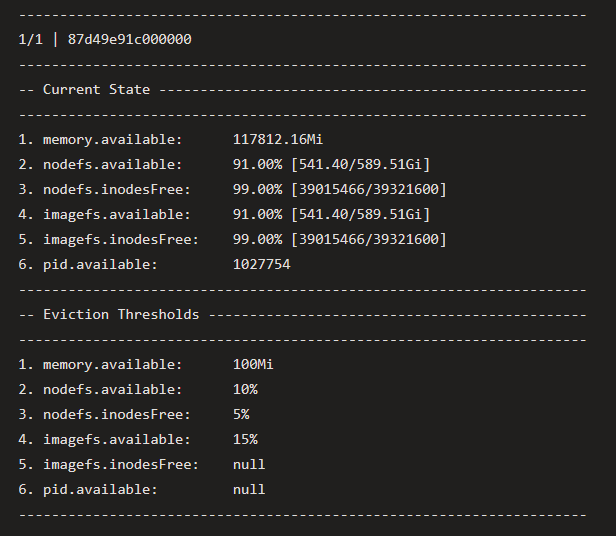
So for example, running print_node_pressure_signals on a loop as workloads progressed allowed us to visually figure out while scrolling through the logs that our Container Runtime was filling up with stale image layers, even though Pods were deleted. As soon as imagefs dipped below 15%, Eviction Manager's Control Loop would fire, and evict pods. This crystal-clear evidence lead us to making a 2 line change that mounted a drive to where imagefs resides, and we never saw Eviction Manager fire again, regardless of how long we left the cluster running:
The same script works for any Kubernetes installs - e.g. K3s:
And here's an example of how to tweak containerd to change the imagefs mount.
Bonus
If you ask ChatGPT to figure out the problem above, this is what you get:
Event though it may look like it, the script doesn't actually work, because it's not even querying the correct API endpoints where you would scrape the same cadvisor signal data kubelet scrapes - the endpoint is not documented anywhere clearly on the internet. ChatGPT must have read the Kubernetes documentation in the original screenshot and made a creative guess.
Unfortunately, I don't think ChatGPT has ever used Kubernetes before.
